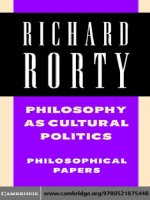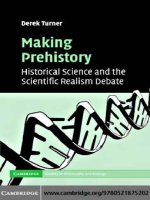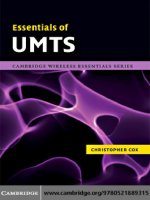cambridge university press a metaphysics for scientific realism knowing the unobservable nov 2007 kho tài liệu bách khoa
Bạn đang xem bản rút gọn của tài liệu. Xem và tải ngay bản đầy đủ của tài liệu tại đây (1.89 MB, 270 trang )
A METAPHYSICS FOR SCIENTIFIC REALISM
Scientific realism is the view that our best scientific theories give approximately
true descriptions of both observable and unobservable aspects of a mindindependent world. Debates between realists and their critics are at the very heart
of the philosophy of science. Anjan Chakravartty traces the contemporary evolution of realism by examining the most promising recent strategies adopted by
its proponents in response to the forceful challenges of antirealist sceptics,
resulting in a positive proposal for scientific realism today. He examines the core
principles of the realist position, and sheds light on topics including the varieties
of metaphysical commitment required, and the nature of the conflict between
realism and its empiricist rivals. By illuminating the connections between realist
interpretations of scientific knowledge and the metaphysical foundations supporting them, his book offers a compelling vision of how realism can provide an
internally consistent and coherent account of scientific knowledge.
anjan chakravartty is Associate Professor at the Institute for the History
and Philosophy of Science and Technology and Department of Philosophy,
University of Toronto.
A METAPHYSICS FOR
SCIENTIFIC REALISM
Knowing the Unobservable
ANJAN CHAKRAVARTTY
University of Toronto
CAMBRIDGE UNIVERSITY PRESS
Cambridge, New York, Melbourne, Madrid, Cape Town, Singapore, São Paulo
Cambridge University Press
The Edinburgh Building, Cambridge CB2 8RU, UK
Published in the United States of America by Cambridge University Press, New York
www.cambridge.org
Information on this title: www.cambridge.org/9780521876490
© Anjan Chakravartty 2007
This publication is in copyright. Subject to statutory exception and to the provision of
relevant collective licensing agreements, no reproduction of any part may take place
without the written permission of Cambridge University Press.
First published in print format 2007
eBook (NetLibrary)
ISBN-13 978-0-511-36768-7
ISBN-10 0-511-36768-6
eBook (NetLibrary)
hardback
ISBN-13 978-0-521-87649-0
hardback
ISBN-10 0-521-87649-4
Cambridge University Press has no responsibility for the persistence or accuracy of urls
for external or third-party internet websites referred to in this publication, and does not
guarantee that any content on such websites is, or will remain, accurate or appropriate.
It is the fault of our science that it wants to explain all; and
if it explain not, then it says there is nothing to explain.
Van Helsing to Dr Seward
Bram Stoker, Dracula
Contents
List of tables
List of figures
Preface
List of abbreviations
page ix
x
xi
xvii
Part I Scientific realism today
1
Realism and antirealism; metaphysics and empiricism
3
The trouble with common sense
A conceptual taxonomy
Metaphysics, empiricism, and scientific knowledge
The rise of stance empiricism
The fall of the critique of metaphysics
3
8
13
17
20
2 Selective scepticism: entity realism, structural realism,
semirealism
27
1.1
1.2
1.3
1.4
1.5
2.1
2.2
2.3
2.4
2.5
3
The entities are not alone
Lessons from epistemic structuralism
Semirealism (or: how to be a sophisticated realist)
Optimistic and pessimistic inductions on past science
The minimal interpretation of structure
27
33
39
45
52
Properties, particulars, and concrete structures
58
Inventory: what realists know
Mutually entailed particulars and structures
Ontic structuralism: farewell to objects?
Ontological theory change
Return of the motley particulars
58
61
70
76
80
3.1
3.2
3.3
3.4
3.5
Part II Metaphysical foundations
4 Causal realism and causal processes
4.1
Causal connections and de re necessity
vii
89
89
Contents
viii
4.2
4.3
4.4
4.5
5
Is causal realism incoherent?
A first answer: relations between events
A better answer: causal processes
Processes for empiricists
96
102
107
114
Dispositions, property identity, and laws of nature
119
The causal property identity thesis
Property naming and necessity
Objections: epistemic and metaphysical
Vacuous laws and the ontology of causal properties
Causal laws, ceteris paribus
119
126
134
141
147
5.1
5.2
5.3
5.4
5.5
6 Sociability: natural and scientific kinds
6.1
6.2
6.3
6.4
6.5
Law statements and the role of kinds
Essences and clusters: two kinds of kinds
Clusters and biological species concepts
Sociability (or: how to make kinds with properties)
Beyond objectivity, subjectivity, and promiscuity
151
151
156
162
168
174
Part III Theory meets world
7 Representing and describing: theories and models
7.1
7.2
7.3
7.4
7.5
Descriptions and non-linguistic representations
Representing via abstraction and idealization
Extracting information from models
The inescapability of correspondence
Approximation and geometrical structures
8 Approximate truths about approximate truth
8.1
8.2
8.3
8.4
8.5
Knowledge in the absence of truth simpliciter
Measuring ‘‘truth-likeness’’
Truth as a comparator for art and science
Depiction versus denotation; description versus reference
Products versus production; theories and models versus practice
References
Index
183
183
187
192
199
205
212
212
214
218
224
230
235
244
Tables
Table 1.1: Scientific realism and antirealisms
Table 6.1: Three types of law-like generalizations
ix
page 10
155
Figures
Figure 1.1: Observables and unobservables
Figure 2.1: Incident, reflected, and refracted light beams
at the interface of two media
Figure 2.2: Property distinctions underlying semirealism
Figure 5.1: Problems associated with vacuous law
statements
Figure 7.1: Using representations and descriptions
x
page 15
35
48
145
186
Preface
This begins as a book about scientific realism. To a very rough, first
approximation, realism is the view that our best scientific theories correctly
describe both observable and unobservable parts of the world. When
philosophers consider this idea they are usually concerned to address the
issue of whether it is a reasonable view to hold. They worry about whether
it gives a plausible account of scientific knowledge, and rightly so! This is
an undeniably important question. It is close to the heart of almost all
issues in the philosophy of science, and importantly relevant to many
issues in philosophy and the sciences more generally. This book, however,
starts with a much more basic and arguably prior question. What is
scientific realism, exactly?
One might think that in order to discuss the question of whether
realism is plausible or reasonable, one should already know what it is.
As philosophers know only too well, however, one cannot think about
everything at once, and the debate surrounding realism is no exception.
One must often assume coherent accounts of various components of a
position in order to give careful attention to others, and people on all sides
of this debate usually take a great deal for granted so as to focus on
epistemic questions. For example, when describing their positions realists
often rely heavily on things such as causation, laws of nature, and the
natural kind structure of the world. These ontological ingredients play
important roles in disputes about realism, but the natures of these things
are generally passed over tout court in these disputes specifically. Their brief
mention leaves open the question of whether such metaphysical foundations are themselves secure enough or otherwise appropriate to support the
edifice of realism.
So, what begins as a book about scientific realism soon becomes a book
about its foundations, and as a consequence this work is not a defence of
realism, per se. Nevertheless, equipped with a better understanding of what
a view entails and does not entail, one may find oneself in a better position
xi
xii
Preface
to defend or condemn it. I believe this to be the case here, and though
my primary objective is not to defend or to condemn, I hope that a
clarification of what realism entails will facilitate further discussion of the
important disputes between realists and antirealists. Currently, much of
what can be said regarding some of these disputes has been said, and in
order to move forward perhaps greater clarity is needed regarding the
nature of this world which realism takes to be illuminated by the sciences.
The metaphysics of realism has lagged behind its epistemology, and one of
the best reasons for addressing the former is to facilitate better the latter.
But the metaphysics of realism comprises a fascinating set of issues on its
own, and in this book I aim to consider them.
Some think there are as many versions of scientific realism as there are
scientific realists. That is probably a conservative estimate! There are
probably as many versions of realism as there are realists and antirealists.
What hope is there, then, for a book about what scientific realism is, let
alone a proposal for a metaphysics supporting it? It would certainly be
impossible to describe realism precisely in a way that would satisfy all
realists and antirealists. No one detailed account answers the descriptive
question of what scientific realism is. That said, I believe there is something
like an account (with negotiable boundaries) that answers the descriptive
question of what some of the best hopes for conceiving realism may be.
Certain elements of realist views appear time and again in divergent
accounts, and their recurrence suggests their centrality to realist approaches
generally. These commonalities merit attention on any version of realism.
No discussion of these matters can hope to be purely descriptive, of course,
and arguments for the many normative suggestions I will make concerning
what I take to be the most promising ways to understand realism appear
throughout. Many will surely disagree with the account of realism argued
for here, but I do hope that realists and antirealists alike will take an interest
in the arguments for why the realism I describe is attractive and defensible.
These arguments serve two distinct but closely related ends. The first is
to identify metaphysical commitments that are importantly constitutive
of realism, and thus crucial to the internal coherence of the position.
Thinking about these commitments helps one to distinguish them from
others that fall outside the immediate context of realism, and to clarify the
ways in which they do and do not conflict with traditional empiricist
rivals. Importantly, though – and I cannot stress this enough – I will not
argue for the exclusive coherence of the metaphysical account I propose.
For reasons discussed in Chapter 1, I suspect that different metaphysical
approaches are consistent with realism and comprise a spectrum, from
Preface
xiii
Humean austerity regarding certain metaphysical questions to the more
elaborate terrain I will map and beyond. The differences between these
approaches have consequences for the sorts of things realists may hope to
explain, and I endeavour to clarify various trade-offs involving ontology
and explanation throughout. The second objective of this work is to give a
unified account of a metaphysical proposal in support of realism, and here
in particular various normative suggestions take centre stage. To summarize the aims of the book very concisely, I investigate the core elements
of promising versions of contemporary realism, and develop a metaphysics
that makes sense of these commitments. The end product, I hope, is a
basic framework with a capacity for elaboration by realists and antirealists
both, as may be appropriate to the specific issues they engage.
Here is a brief description of the contents by chapter. The first part of the
book, ‘Scientific realism today’, sketches a preliminary account of the
central commitments of realism as they have evolved over time and quite
recently, often in response to antirealist scepticism. The essence of the
controversy between realists and antirealists concerns the possibility of
having knowledge of the unobservable, and this possibility is most strongly
contested by varieties of empiricism. In Chapter 1, I introduce the idea of
realism in the context of the sciences and consider the dialectic between this
position and the forms of empiricism that dispute it, thus illuminating
some different senses in which realism is apparently metaphysical. In
Chapter 2, I develop this initial sketch of realism by considering what I take
to be its most promising formulations, such as entity realism and structural
realism, in order to produce a portrait of the position that incorporates the
best of their insights and avoids their defects. The resulting inventory of
realist commitment, to certain properties, relations, and particulars, and
various connections between them are explored in Chapter 3.
‘Metaphysical foundations’, the second part of the book, delves more
deeply into the ontological issues raised by the contemporary view of
realism offered in Part I. The internal coherence of realism depends in part
on the possibility of articulating an integrated and compelling account of
these issues, and I articulate one such account here. Chapter 4 examines
the issue of causation, on which much of the justificatory story of realism
depends, and argues that its role in this story is nicely facilitated by a
specific understanding of causal phenomena in terms of processes and
dispositions. This discussion is extended in Chapter 5 to a consideration of
laws of nature, where I argue that the natures of causal properties and the
dispositions they confer lend themselves to a promising and metaphysically minimal account of natural necessity. Moving from an investigation
xiv
Preface
of properties and relations to objects, Chapter 6 focuses on the role played
in realist discourse by the concept of natural kinds. I argue that a proper
understanding of this concept results in a dissolution of the traditional
dichotomy between objective and subjective classification, and a rejection
of certain vestiges of ancient metaphysics, outmoded in the context of
realism today.
In the final part of the book, ‘Theory meets world’, I consider several
matters arising from Parts I and II that overlap the hazy boundary between
the metaphysics and the epistemology of realism. In Chapter 7, I examine
the use of models to represent parts of the world, and the question of
whether the ‘‘ontological’’ nature of scientific theories, conceived either
linguistically or in terms of models, has any bearing on the epistemic
commitments of realism. Chapter 8 builds on this discussion by giving an
amalgamated account of certain features of theories and models that have
implications for a realist understanding of scientific knowledge. Drawing
analogies to representation in art, these features include the use of
abstraction and idealization, and the notion of approximate truth.
It is sometimes said that scientific realism is a perennial issue of philosophy. Indeed, one of the implicit themes of this book is that some
disputes between realists and antirealists, not to mention disputes between
realists with different philosophical predispositions, are destined to remain
unresolved due to an irresolvable lack of shared assumptions. To a great
extent, these assumptions concern the metaphysical aspects of realism. It
seems unlikely to me that there are convincing responses to all forms of
antirealist scepticism, and it seems even less likely that there are any knockdown arguments against them. Some forms of scepticism are, no doubt,
coherent philosophical positions, and it is doubtful whether there are any
non-question-begging arguments that will decide these matters ultimately.
If one is interested in realism, however – in seeing whether it can be
understood as an engaging, coherent, compelling account of the sciences –
then much work remains to be done. If one feels any pull in this direction,
then it is crucial that one have recourse to an internally consistent and
substantive position. It is the goal of this book to furnish a unified picture
of the metaphysics of scientific realism with which to answer this challenge. It aspires to give a wide-ranging answer to the question of what sort
of realist a sophisticated realist can be.
Much of the book took shape while I was a Visiting Fellow at the Center
for Philosophy of Science at the University of Pittsburgh in 2004. I am
grateful for that opportunity, as well as to the Social Sciences and
Humanities Research Council of Canada for financial support. I am also
Preface
xv
thankful to the following journals and publishers for permission to make
use of work published previously. Sections 1.4 and 1.5 extend arguments
found in ‘Stance Relativism: Empiricism versus Metaphysics’, Studies in
History and Philosophy of Science 35: 173–84, ª 2004 Elsevier B. V., all
rights reserved. Sections 2.2–2.5 are based on material in ‘Structuralism as a
Form of Scientific Realism’, International Studies in the Philosophy of
Science 18: 151–71, ª 2004 Taylor & Francis Group, all rights reserved.
Section 3.2 is a reworking of parts of ‘Semirealism’, Studies in History
and Philosophy of Science 29: 391–408, ª 1998 Elsevier B. V., all rights
reserved, and sections 3.3–3.5 are adapted from ‘The Structuralist Conception of Objects’, Philosophy of Science 70: 867–78, ª 2003 Philosophy
of Science Association, all rights reserved. Chapter 4 is based on ‘Causal
Realism: Events and Processes’, Erkenntnis: 63: 7–31, ª 2005 Springer
Science & Business Media, all rights reserved, and Chapter 5 is adapted
from ‘The Dispositional Essentialist View of Properties and Laws’,
International Journal of Philosophical Studies 11: 393–413, ª 2003 Taylor &
Francis Group, all rights reserved. Sections 7.2–7.5 rework arguments
found in ‘The Semantic or Model-Theoretic View of Theories and
Scientific Realism’, Synthese 127: 325–45, ª 2001 Springer Science &
Business Media, all rights reserved.
Before getting under way there are also a number of people I must
thank. I have benefited immensely from discussions with them, and all of
the following were kind enough to read earlier drafts of some part of this
material at one stage or another. I owe a great debt to David Armstrong,
Alexander Bird, Simon Bostock, Bryson Brown, James Robert Brown,
Ota´vio Bueno, Jeremy Butterfield, Krister Bykvist, Pierre Cruse, Thomas
Dixon, Brian Ellis, Jason Grossman, Anandi Hattiangadi, Katherine
Hawley, Eric Heatherington, Nick Jardine, Jeff Ketland, Martin Kusch,
James Ladyman, Tim Lewens, Gordon McOuat, Hugh Mellor, Stephen
Mumford, Robert Nola, Stathis Psillos, Michael Redhead, Michael Rich,
Juha Saatsi, Howard Sankey, Peter Smith, Kyle Stanford, Paul Teller,
Martin Thomson-Jones, and Bas van Fraassen. I am very grateful to
Matthias Frisch and to a reader for Cambridge University Press, whose
excellent comments on the entire manuscript and attention to detail led to
many improvements, to Hilary Gaskin and Jo Breeze at the Press for
steering this project through so helpfully, to Jo Bramwell for her copyediting skills, and to Steve Russell for the index. The incredible generosity
and thoughtfulness of Peter Lipton, Steven French, and Margie Morrison
have been an unremitting inspiration. Thanks go to my family for their
support: my parents, my sister, the Gangulys, the Jacksons, and the gang.
xvi
Preface
Three final remarks are in order concerning the chapters to follow.
Single quotation marks indicate quotation, or the mention of a term or
phrase. Double quotation marks indicate the (generally figurative or
metaphorical) use of a term or phrase. Lastly, a warning: I have made
extensive reference to many tempting desserts. The reader is advised to
snack before reading.
Abbreviations
DIT
ER
IBE
NE
NOA
PI
PII
QM
SD
SR
UTD
dispositional identity thesis, for causal properties
entity realism
inference to the best explanation, sometimes called abduction
the New Essentialism, concerning scientific ontology
the natural ontological attitude
pessimistic induction, or pessimistic meta-induction
principle of the identity of indiscernibles
quantum mechanics
Salmon-Dowe (causal process)
structural realism
the underdetermination of theory choice by data or evidence
xvii
part i
Scientific realism today
c h ap t e r 1
Realism and antirealism; metaphysics
and empiricism
1.1 the trouble with common sense
Hanging in my office is a framed photograph of an armillary sphere,
which resides in the Whipple Museum of the History of Science in
Cambridge, England. An armillary sphere is a celestial globe. It is made
up of a spherical model of the planet Earth (the sort we all played with as
children), but the model is surrounded by an intricate skeleton of graduated rings, representing the most important celestial circles. Armillary
spheres were devised in ancient Greece and developed as instruments for
teaching and astronomical calculation. During the same period, heavenly
bodies were widely conceived as fixed to the surfaces of concentrically
arranged crystalline spheres, which rotate around the Earth at their centre.
This particular armillary sphere has, I expect, many fascinating historical
stories to tell, but there is a specific reason I framed the picture. Once upon
a time, astronomers speculated about the causes and mechanisms of the
motions of the planets and stars, and their ontology of crystalline spheres
was a central feature of astronomical theory for hundreds of years. But
crystalline spheres are not the sorts of things one can observe, at least not
with the naked eye from the surface of the Earth. Even if it had turned out
that they exist, it is doubtful one would have been able to devise an
instrument to detect them before the days of satellites and space shuttles.
Much of the energy of the sciences is consumed in the attempt to work out
and describe things that are inaccessible to the unaided senses, whether in
practice or in principle. My armillary sphere, with its glorious and complicated mess of interwoven circles, is a reminder of past testaments to that
obsession.
In describing the notion of a crystalline sphere, I have already made
some distinctions. There are things that one can, under favourable
circumstances, perceive with one’s unaided senses. Let us call them
‘‘observables’’, though this is to privilege vision over the other senses for the
3
4
Realism and antirealism; metaphysics and empiricism
sake of terminological convenience. Unobservables, then, are things one
cannot perceive with one’s unaided senses, and this category divides into
two subcategories. Some unobservables are nonetheless detectable through
the use of instruments with which one hopes to ‘‘extend’’ one’s senses, and
others are simply undetectable. These distinctions are important, because
major controversies about how to interpret the claims of the sciences
revolve around them. In this chapter, I will briefly outline the most
important positions engaged in these controversies, and consider how
the tension between speculative metaphysics and empiricism has kept
them alive.
There are occasional disputes about what counts as science – concerning how best to exclude astrology but include astronomy, about what to
say to creationists unhappy with the teaching of evolutionary biology in
schools, etc. I leave these disputes to one side here, and begin simply with
what are commonly regarded as sciences today. It is widely held that the
sciences are not merely knowledge-producing endeavours, but the means
of knowledge production par excellence. Scientific inquiry is our best hope
for gaining knowledge of the world, the things that compose it, its
structure, its laws, and so on. And the more one investigates, the better it
gets. Scientific knowledge is progressive; it renders the natural world with
increasing accuracy.
Scientific realism, to a rough, first approximation, is the view that scientific theories correctly describe the nature of a mind-independent world.
Outside of philosophy, realism is usually regarded as common sense, but
philosophers enjoy subjecting commonplace views to thorough scrutiny,
and this one certainly requires it. The main consideration in favour of
realism is ancient, but more recently referred to as the ‘miracle argument’
(or ‘no-miracles argument’) after the memorable slogan coined by Hilary
Putnam (1975, p. 73) that realism ‘is the only philosophy that doesn’t make
the success of science a miracle’. Scientific theories are amazingly successful
in that they allow us to predict, manipulate, and participate in worldly
phenomena, and the most straightforward explanation of this is that they
correctly describe the nature of the world, or something close by. In the
absence of this explanation the success afforded by the sciences might well
seem miraculous, and, given the choice, one should always choose common sense over miracles.
Some have questioned the need for an explanation of the success of
science at all. Bas van Fraassen (1980, pp. 23–5, 34–40), for example,
suggests that successful scientific theories are analogous to well-adapted
organisms. There is no need to explain the success of organisms, he says.
The trouble with common sense
5
Only well-adapted organisms survive, just as only well-adapted theories
survive, where ‘well-adapted’ in the latter case means adequate to the tasks
to which one puts theories. These tasks are generally thought to include
predictions and retrodictions (predictions concerning past phenomena),
and perhaps most impressively novel predictions (ones about classes of
things or phenomena one has yet to observe). A well-adapted theory is
one whose predictions, retrodictions, and novel predictions, if any, are
borne out in the course of observation and experimentation. But saying
that successful theories are ones that are well-adapted may be tantamount
to the tautology that successful theories are successful, which is not saying
much. Whatever the merits of the Darwinian analogy for theories generally, one might still wonder why any given theory (organism) survives
for the time it does, and this may require a more specific consideration of
the properties of the theory (organism) in virtue of which it is well adapted. I will return to the contentious issue of the demand for explanations
later in this chapter.
The attempt to satisfy the desire for an explanation of scientific success
has produced the bulk of the literature on scientific realism. As arguments
go, the miracle argument is surprisingly poor, all things considered, and
consequently alternatives to realism have flourished. The poverty of the
miracle argument and consequent flourishing of rivals to realism stem
from difficulties presented by three general issues, which I will mention
only briefly:
1 the use of abductive inference, or inference to the best explanation
(IBE)
2 the underdetermination of theory choice by data or evidence (UTD)
3 discontinuities in scientific theories over time, yielding a pessimistic
induction (PI)
Abduction is a form of inference famous from the writings of Charles
Saunders Pierce, inspiring what is now generally called ‘inference to the
best explanation’ (some use the term synonymously with ‘abduction’
while others, more strictly, distinguish it from Pierce’s version). IBE offers
the following advice to inference makers: infer the hypothesis that, if true,
would provide the best explanation for whatever it is you hope to explain.
Note that the miracle argument itself is an abductive argument. Why are
scientific theories so successful at making predictions and accounting for
empirical data? One answer is that they are true, and this seems, to the
realist at any rate, the best explanation. One might even think it the only
conceivable explanation, but as we shall see, in light of UTD and PI,
6
Realism and antirealism; metaphysics and empiricism
this is highly contestable. First, however, let us turn from the particular
case of the miracle argument to the merits of IBE as a form of inference
in general. There is little doubt that this sort of inferential practice is
fundamental to everyday and scientific reasoning. The decision to adopt
one theory as opposed to its rivals, for example, is generally a complex
process involving many factors, but IBE will most certainly figure at
some stage.
Antirealists are quick to point out that in order for an instance of IBE to
yield the truth, two conditions must be met. Firstly, one must rank the rival
hypotheses under consideration correctly with respect to the likelihood
that they are true. Secondly, the truth must be among the hypotheses one is
considering. But can one ensure that these conditions are met? Regarding
the first, it is difficult to say what features a truth-likely explanation should
have. Beyond the minimum criterion of some impressive measure of
agreement with outcomes of observation and experiment, possible indicators of good explanations have been widely discussed. Some hold that
theories characterized by features such as simplicity, elegance, and unity
(with other theories or domains of inquiry) are preferable. Quite apart
from the matter of describing what these virtues are, however, and knowing
how to compare and prioritize them, it is not immediately obvious that
such virtues have anything to do with truth. There is no a priori reason, one
might argue, to reject the possibility that natural phenomena are rather
complex, inelegant, and disjoint. And regarding the second condition for
successful IBE, in most cases it is difficult to see how one could know in
advance that the true hypothesis is among those considered.1
In practice it is often difficult to produce even one theory that explains
the empirical data, let alone rivals. This, however, does not diminish the
seriousness of the problem. In fact, it turns out that it may be irrelevant
whether one ever has a choice to make between rival theories in practice.
For some maintain that rival theories are always possible, whether or not
one has thought of them, and this is sufficient to raise concerns about IBE.
Confidence in the possibility of rivals stems from the underdetermination
thesis, or UTD. Its canonical formulation due to Pierre Duhem, later
expressed in rather different terms by W. V. O. Quine (hence also called
the ‘Duhem-Quine thesis’), goes this way. Theoretical hypotheses rarely
if ever yield predictions by themselves. Rather, they must be conjoined
with auxiliary hypotheses – background theories, related theories, theories
1
A case in which one does have this knowledge is where rival hypotheses are contradictories. See
Lipton 1993 for a discussion of this and its implications for IBE.









